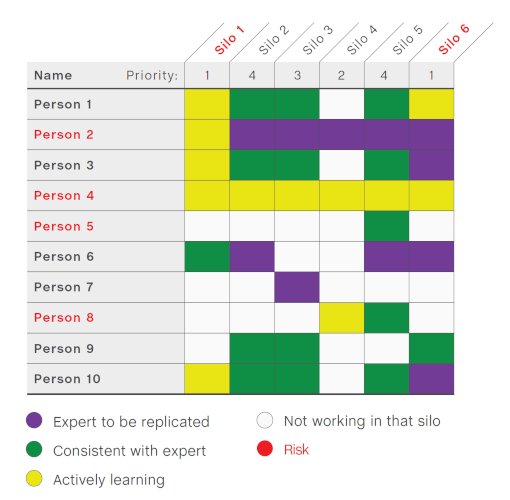Your company can only move as fast as your experts. I was reminded of this fact when I heard a story on NPR’s Marketplace. The host was profiling the Cup & Saucer Café, which has three locations in Portland, Oregon. The Manager, Aimee Drake is always looking to hire, but while wait staff are fairly easy to find, cooks are a whole different story.
“It is a very specialized skill, particularly for us, being a high-volume restaurant,” explains Aimee. “The owner often steps up to fill in that position.” Because of this dependence on a few expert staff, customers end up waiting longer for their orders and on the worst days, some Cup & Saucer Café locations can’t open at all – so the company loses money.
 Corporate executives have shared versions of this story with me for 20+ years. And the revenue loss they’re talking about? It’s in the millions. All because their uniquely skilled staff are spread too thin. Wayne Shurts, the Executive VP of Sysco Foods, calls these people “pacers” – because the company can only move as fast as these experts are available.
Corporate executives have shared versions of this story with me for 20+ years. And the revenue loss they’re talking about? It’s in the millions. All because their uniquely skilled staff are spread too thin. Wayne Shurts, the Executive VP of Sysco Foods, calls these people “pacers” – because the company can only move as fast as these experts are available.
 They rarely know how they got themselves into this pickle and would be grateful to get out of it, so here’s a place to start.
Figure out exactly what your pacers are working on and who they’re working with. I like to use a handy matrix like the one shown here. Across the top, identify the areas of work (I call them silos). On the left, identify the different people on your team. And in the boxes, indicate the level of expertise each person brings to the work. Your pacer will mostly likely look like Person 2 because they’re the go-to person in multiple areas of work.
They rarely know how they got themselves into this pickle and would be grateful to get out of it, so here’s a place to start.
Figure out exactly what your pacers are working on and who they’re working with. I like to use a handy matrix like the one shown here. Across the top, identify the areas of work (I call them silos). On the left, identify the different people on your team. And in the boxes, indicate the level of expertise each person brings to the work. Your pacer will mostly likely look like Person 2 because they’re the go-to person in multiple areas of work.
 Corporate executives have shared versions of this story with me for 20+ years. And the revenue loss they’re talking about? It’s in the millions. All because their uniquely skilled staff are spread too thin. Wayne Shurts, the Executive VP of Sysco Foods, calls these people “pacers” – because the company can only move as fast as these experts are available.
Corporate executives have shared versions of this story with me for 20+ years. And the revenue loss they’re talking about? It’s in the millions. All because their uniquely skilled staff are spread too thin. Wayne Shurts, the Executive VP of Sysco Foods, calls these people “pacers” – because the company can only move as fast as these experts are available.
This Article Covers
5 Steps To Solve Bottleneck Problems and Increase Productivity
So … what do you do? Here are 5 steps you can take to clear bottlenecks and increase productivity on your team.Step 1: Identify Your Pacers
Make a list of the pacers on your team. If you’re like most of the executives I work with, it won’t be a long list – probably 10-12 for a team of 500. And it’s not a secret list. Everyone knows who the pacers are because so many people are waiting for them at one time or another – waiting for feedback, trying to start meetings, postponing decisions, etc. Pacers have a rare combination of experience, technical expertise, judgment and political capital. Sometimes they also have power, but often they are not senior leaders. They’re just really smart and really good at their jobs. Over time, they become indispensable, so much so that when anything “big” happens, they appear to be the only one who can help out.Step 2: Calculate Revenue & Productivity Loss
Estimate how much revenue growth or cost reduction is slowed because your pacers are doing something else. Share that information with your boss and other colleagues. Ask if they agree or would modify your list and estimates. See if they think it would be worthwhile to solve this problem. And just to get your gears turning, here’s what a Fortune 500 VP recently told me. There is a data analyst who works outside of the VP’s company, but is routinely needed for projects. This analyst was too busy to work on an RFP for a billion dollars in new business. That is billion with a “B.” What could be more important? Turns out the analyst had too many other meetings on his calendar – bogged down in problems and projects that were “big” for the wrong reasons.Step 3: Figure Out What Your Pacers Are Doing
The first thing to remember is that pacers do not operate in a vacuum. They are part of a larger ecosystem that can be organized to ensure they provide the highest value while also keeping the waste, burnout and frustration to a minimum. It is very unlikely that they’re trying to be pacers, despite how it may look sometimes. They rarely know how they got themselves into this pickle and would be grateful to get out of it, so here’s a place to start.
Figure out exactly what your pacers are working on and who they’re working with. I like to use a handy matrix like the one shown here. Across the top, identify the areas of work (I call them silos). On the left, identify the different people on your team. And in the boxes, indicate the level of expertise each person brings to the work. Your pacer will mostly likely look like Person 2 because they’re the go-to person in multiple areas of work.
They rarely know how they got themselves into this pickle and would be grateful to get out of it, so here’s a place to start.
Figure out exactly what your pacers are working on and who they’re working with. I like to use a handy matrix like the one shown here. Across the top, identify the areas of work (I call them silos). On the left, identify the different people on your team. And in the boxes, indicate the level of expertise each person brings to the work. Your pacer will mostly likely look like Person 2 because they’re the go-to person in multiple areas of work.
